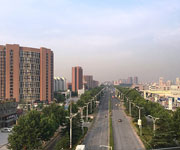
Nanjing is the capital of Jiangsu province in Eastern China. Located in the lower Yangtze River drainage basin and Yangtze River Delta economic zone, it was a prominent place in Chinese history and culture, having been the capital of China for several periods and was recognized as one of the Four Great Ancient Capitals of China. Now, Nanjing has been ranked seventh in the evaluation of “Cities with strongest Comprehensive Strength” issued by the National statistics Bureau. Nanjing has been the educational center in southern China for more than 1700 years. Currently, it boasts of some of the most prominent educational institutions in the region like China Pharmaceutical University, Nanjing University, etc. With its special characteristics, many international students choose to study in Nanjing.
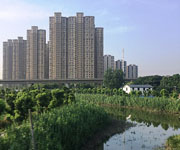
Zhenjiang (Chinese Postal Map Romanisation: Chenkiang; simplified Chinese: 镇江; traditional Chinese: 鎮江; pinyin: Zhènjiāng) is a city in Jiangsu province, in eastern China. Sitting on the southern bank of the Yangtze River, Zhenjiang is governed as a Prefecture-level city; it borders the provincial capital of Nanjing to the west, Changzhou to the east, and Yangzhou across the river to the north. Once known as Jingjiang (Chinese: 京江; Chinese Postal Map Romanisation: Kingkiang) or Jingkou (Chinese: 京口; Chinese Postal Map Romanisation: Kingkow), Zhenjiang is today an important transportation hub, owing to its location near the intersection of the Yangtze River and the Grand Canal.
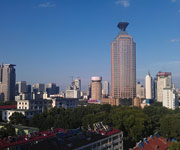
Jinan (Chinese: 济南市) is the capital of Shandong province in Eastern China. The area of present-day Jinan has played an important role in the history of the region from the earliest beginnings of civilization and has evolved into a major national administrative, economic, and transportation hub. The city has held sub-provincial administrative status since 1994. Jinan is often referred to as the 'Spring City' for its well-known 72 artesian springs inside urban area. Its population was 6,813,984 at the 2010 census whom 4,335,989 lived in the built-up (or metro) area made up of 6 urban districts.
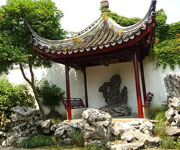
Suzhou, formerly romanized as Soochow, is a major city in the southeast of Jiangsu Province in Eastern China, adjacent to Shanghai Municipality. It is a major economic centre and focal point of trade and commerce, and the second largest city in the province after its capital Nanjing. The city is situated on the lower reaches of the Yangtze River and the shores of Lake Tai and belongs to the Yangtze River Delta region. Administratively, Suzhou is a prefecture-level city with a population of 4.33 million in its city proper, and a total resident population (as of 2013) of 10.58 million in its administrative area, which incorporates neighboring suburban regions and the satellite cities of Kunshan, Lianyungang, Taicang, and Changshu. Its urban population grew at an unprecedented rate of 6.5% between 2000 and 2014, which is the highest among cities with more than 5 million people. Founded in 514 BC, Suzhou has over 2,500 years of history, with an abundant display of relics and sites of historical interest. At around 100 AD, during the Eastern Han Dynasty, it became one of the ten largest cities in the world mostly due to emigration from North China. Since the 10th-century Song Dynasty, it has been an important commercial center of China. During the Ming and Qing Dynasty, Suzhou was a national economic, cultural and commercial center, as well as the largest non-capital city in the world, until the 1860 Taiping Rebellion. When Li Hongzhang and Charles George Gordon recaptured the city three years later, Shanghai had already taken its predominant place in the nation. Since major economic reforms began in 1978, Suzhou has become one of the fastest growing major cities in the world, with GDP growth rates of about 14% in past 35 years. With high per capita incomes, Suzhou's Human Development Index ratings is roughly comparable to a moderately developed country, making it one of the most highly developed and propserous cities on the Chinese mainland.
Chengde (Chinese: 承德; pinyin: Chéngdé), previously known as Jehol or Rehe (simplified Chinese: 热河; traditional Chinese: 熱河; pinyin: Rèhé), is a prefecture-level city in Hebei province, situated northeast of Beijing. It is best known as the site of the Mountain Resort, a vast imperial garden and palace formerly used by the Qing emperors as summer residence. The urban center had a population of approximately 450,000 as of 2009.
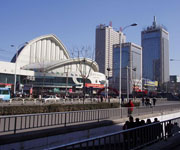
Shijiazhuang (Chinese: 石家庄; pinyin: Shíjiāzhuāng), also written Shikiachwang or Shihkiachwang, is the capital and largest city of North China's Hebei province.[1] Administratively a prefecture-level city, it is about 263 kilometres (163 mi) southwest of Beijing, and it administers 6 districts, 5 county-level cities, and 12 counties. At the 2010 census, it had a total population of 10,163,788, with 2,766,614 in the urban area and 4,770,400 in the built-up (or metro) area comprising the 5 urban districts, the counties of Zhengding and Luancheng, Luquan City and now Gaocheng City largely conurbated with the Shijiazhuang metropolitan area as urbanization continues to proliferate. Shijiazhuang's total population ranked twelfth in mainland China. Shijiazhuang is a modernizing and ever growing city. It experienced dramatic growth after the founding of the People's Republic of China in 1949. The population of the metropolitan area has more than quadrupled in only 30 years as a result of fast industrialization and major infrastructural developments. Shijiazhuang is a major transportation hub in the region which has contributed to the city's fast growth and development. From 2008 to 2011, Shijiazhuang implemented a three-year plan which concluded with the reorganization of the city resulting in an increase of green areas and improved urbanization (new buildings, new roads and road plans). The three-year plan was a success and even after it ended, the city continues to benefit from the major projects that were implemented with the opening of a new train station, a new airport and a subway system. Even with the green areas, however, Shijiazhuang continues to suffer from pollution. The top ten cities that suffered the most days of severe pollution includes Shijiazhuang.
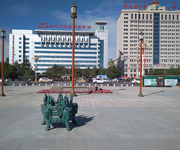
Hulunbuir or Hūlúnbèi'ěr (Mongolian: ᠬᠥᠯᠥᠨ ᠪᠤᠶᠢᠷ ᠬᠣᠲᠠ Kölön Buyir qota; Chinese: 呼伦贝尔市) is a region that is governed as a prefecture-level city in northeastern Inner Mongolia, in the People's Republic of China. Its administrative center is located at Hailar District, its largest urban area. Major scenic features are the high steppes of the Hulun Buir grasslands, the Hulun and Buir lakes (the latter partially in Mongolia), and the Khingan range. Hulun Buir borders Russia to the north and west, Mongolia to the south and west, Heilongjiang province to the east and Hinggan League to the direct south. Hulunbuir is a linguistically diverse area: next to Mandarin Chinese, Mongolian dialects such as Khorchin and Buryat, the Mongolic language Dagur and some Tungusic languages are spoken there.

Taiyuan (Chinese: 太原; pinyin: Tàiyuán [tʰaɪ̂ɥɛ̌n], also known as Bing (并), Jinyang (晋阳)) is the capital and largest city of North China's Shanxi province.[2] At the 2010 census, it had a total population of 4,201,591 inhabitants on 6,959 km2 (2,687 sq mi), from whom 3,212,500 are urban on 1,460 km2 (560 sq mi). The name of the city literally means "Great Plains", referring to the location where the Fen River leaves the mountains. The city is located at the centre of the province with an East-West span of 144 km and a North-South span of 107 km.
Benxi (Chinese: 本溪; pinyin: Běnxī) is a prefecture-level city located in the east of Liaoning province, People's Republic of China, south-southeast of Shenyang. Its population was 1,709,538 at the 2010 census whom 1,011,377 lived in the built-up area made of 3 urban districts (Pinshan, Xihu and Mingshan). It was founded as a metallurgical center in 1915. Benxi Iron and Steel Company ("Bengang") is the largest employer in the city, and used to be the fourth-largest steel company in China. The second-largest industry in Benxi is coal mining. Benxi has pollution problems due to steel production and coal mining. During the disaster of Air France flight AF447, Benxi Iron and Steel Company lost 5 employees, including the executive Chen Chiping who was the wife of Liaoning's provincial governor.

Jinzhou (simplified Chinese: 锦州; traditional Chinese: 錦州; pinyin: Jǐnzhōu), is a prefecture-level city of Liaoning province, People's Republic of China. It is a geographically strategic city located in the "Liaoxi Corridor" (辽西走廊), which connects land transportation between North China and Northeast China. Jinzhou is China's northernmost seaport and the coastal economic center of West Liaoning on the north-western shore of the Bohai Sea. The total area under the jurisdiction of Jinzhou is 10,111 square kilometres (3,904 sq mi), most of which is rural, encompassing a coastline of 97.7 km (60.7 mi). It is one of the biggest cities in Liaoning with a population of 3,126,463 at the 2010 census, of whom 1,091,799 reside in the built-up area made of 3 urban districts.
Huainan (Chinese: 淮南; pinyin: Huáinán) is a prefecture-level city with 2,334,000 inhabitants in central Anhui Province, People’s Republic of China. It borders the provincial capital of Hefei to the south, Lu’an to the southwest, Fuyang to the west, Bozhou to the northwest, Bengbu to the northeast and Chuzhou to the east. Its built-up area is home to 1,938,212 inhabitants in 2010 spread out on 4 urban districts (Tianjia'an, Datong, Xiejiaji, Bagongshan and 1 county Fengtai) nowadays in agglomeration.
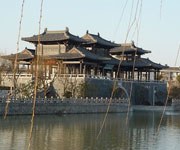
Yangzhou (simplified Chinese: 扬州; traditional Chinese: 揚州; pinyin: Yángzhōu) is a prefecture-level city in central Jiangsu province in the People's Republic of China. Sitting on the northern bank of the Yangtze River, it borders the provincial capital of Nanjing to the southwest, Huai'an to the north, Yancheng to the northeast, Taizhou to the east, and Zhenjiang across the river to the south. Its population is 4,414,681 at the 2010 census and its built up area is home to 2,146,980 inhabitants including three urban districts plus currently in the agglomeration. Historically it is one of the wealthiest of China's cities, known at various periods for its great merchant families, poets, painters, and scholars. Its name (lit. "Rising Prefecture") refers to its former position as the capital of Yangzhou prefecture in imperial China.
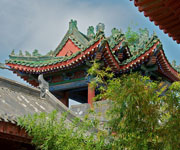
Kaifeng (simplified Chinese: 开封; traditional Chinese: 開封; pinyin: Kāifēng; Wade–Giles: K'aifeng), known previously by several names (see below), is a prefecture-level city in east-central Henan province, People's Republic of China. It was once the capital of the Northern Song Dynasty. There are currently nearly 5 million people living in its metropolitan area. Located along the southern bank of the Yellow River, it borders the provincial capital of Zhengzhou to the west, Xinxiang to the northwest, Shangqiu to the east, Zhoukou to the southeast, Xuchang to the southwest, and the province of Shandong to the northeast.
Huaihua lies is in the mountainous west of Hunan, south-east of Zhangjiajie National Forest Park, and shares the same mountain belt. The area's rural poverty is a continuing problem. Railroads provide the main transportation in the region, although an airport was opened in 2004. Huaihua is home to the Second Artillery Corps Base 55, which is charged with maintaining ICBMs. The nuclear assets at Huaihua are intended for small-scale nuclear conflicts (with a limited, but nuclear, exchange), as well as the ability to strike Guam, one of only two B-2 bases.
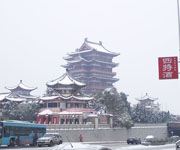
Nanchang (Chinese: 南昌; pinyin: Nánchāng) is the capital of Jiangxi Province in southeastern China, located in the north-central portion of the province. It is bounded on the west by the Jiuling Mountains, and on the east by Poyang Lake. Because of its central location relative to the Yangtze and Pearl River Delta regions, it is a major railroad hub in Southern China. Its population was 5,042,566 whom 4,171,926 in the built-up area made up of six urban districts plus the urbanized counties of Nanchang and Xinjian. As the Bayi Riot 1927 was distinctively recognized by the ruling Communist Party as "firing the first gunshot against the evil Republic of China", the current communist regime has therefore named the city since 1949 "the City of Heroes", "the place where the People's Liberation Army was born", and the most widely known "place where the military banner of the People's Liberation Army was first raised".
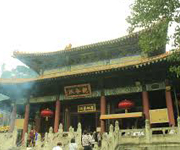
Foshan (Chinese: 佛山), is a prefecture-level city in central Guangdong province, People's Republic of China. The area under the city's jurisdiction is about 3,848.49 km2 (1,485.91 sq mi) and currently has a population of 7.2 million all urban. It's part of probably the most important built-up area in the world, the Pearl River Delta Mega City with more than 44,78 million inhabitants at the 2010 census spread on 9 municipalities (including Macao) and 17,573 km2. The native dialect is the Foshan variant of Cantonese, but many areas of Foshan are now occupied by Mandarin-speaking migrants.
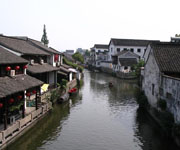
Shaoxing (help·info) is a prefecture-level city on the southern shore of Hangzhou Bay in northeastern Zhejiang province, China. It was formerly known as Kuaiji and Shanyin and abbreviated in Chinese as 越 (Yuè) from the area's former inhabitants. Located on the south bank of the Qiantang River estuary, it borders Ningbo to the east, Taizhou to the southeast, Jinhua to the southwest, and Hangzhou to the west. The city itself is lined with numerous canals and waterways, giving it a classic Jiangnan style scenery though more mountainous than is typical for Jiangnan. At the 2010 census, its population was 4,912,339 inhabitants whom 1,914,683 (Keqiao and Yuecheng districts) lived in the built-up area of Hangzhou-Shaoxing, with 8,156,154 inhabitants. Shaoxing has long been a hotbed of Chinese cultural activity, producing such luminary figures as Wang Xizhi, Zhou Enlai, Lu Xun, and Cai Yuanpei. It is widely known throughout China for Shaoxing wine, meigan cai, and stinky tofu, and was recently featured on A Bite of China. Its local variety of Chinese opera sung in the local dialect and known as Yue or Shaoxing opera is second in popularity only to Peking opera. In 2010, Shaoxing celebrated the 2500th anniversary of the founding of the city. Economically, the city's driven by manufacturing of textiles, electronics, and energy efficient lighting. Zhejiang has the fifth highest per capita GDP in the nation, with the city itself at 32nd nationally by GDP per capita.
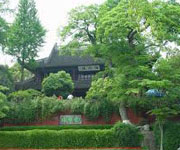
Jiaxing (Chinese: 嘉兴; pinyin: Jiāxīng; Wu Chinese: Gāshīng [kɑɕiŋ]) is a prefecture-level city in northern Zhejiang province, People's Republic of China. Lying on the Grand Canal of China, Jiaxing borders Hangzhou to the southwest, Huzhou to the west, Shanghai to the northeast, and the province of Jiangsu to the north. At the 2010 census, its population was 4,501,657 and its built-up area made of 2 urban districts was home to 1,201,882 inhabitants.
 Immediate attention
Immediate attention